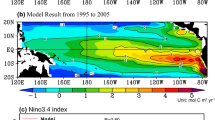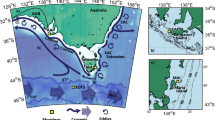Abstract
A simple biogeochemical model coupled to an offline ocean tracer transport model driven by reanalysis ocean data is used to simulate the seasonal and interannual CO\(_2\) flux variability in the northern Indian Ocean. The maximum of seasonal and interannual CO\(_2\) emission variances in the northern Indian Ocean are located in the coastal Arabian Sea (AS) and Southern Peninsular India (SP) with a basin-wide seasonal amplitude and standard deviation of 0.044\(\pm \)0.04 Pg C year\(^{-1}\). The area integrated CO\(_2\) emissions from these two regions in the model are significantly correlated (above a 95 % level) with the observations of Takahashi et al. (Deep-Sea Res-II, 56:554–577, 2009). The interannual anomalies of CO\(_2\) emission from the AS and SP are found as 40 and 30 % of their respective seasonal amplitudes. Both the Arabian Sea (AS) and Southern Peninsular India (SP) interannual CO\(_2\) emission anomalies show a 3–4-year variability. The correlations of AS and SP CO\(_2\) emission anomalies with the Indian Ocean Dipole/Zonal Mode (IODZM) and Southern Oscillation (SO) indices from 1980 to 1999 are 0.35, 0.21 and 0.32, 0.01 respectively. A 5-year window moving correlation analysis shows that the relationship of AS and SP CO\(_2\) emission to the SO and IODZM are complementary to each other. During the years when the correlation of air–sea CO\(_2\) emission with the IODZM is stronger, the corresponding correlation with the SO is weaker or opposite. The total change in pCO\(_2\) is broken down into changes induced by the individual components such as dissolved inorganic carbon (DIC), sea surface temperature (SST), alkalinity, and salinity and found that (1) the effect of SST in the AS CO\(_2\) emission increases (decreases) when the correlation of CO\(_2\) emission with the IODZM is positive (negative), and (2) the SP CO\(_2\) emission is strongly controlled by the circulation-driven DIC changes; however, this relation is found to be weaker when the SO correlates negatively with the SP CO\(_2\) emission.






Similar content being viewed by others
References
Ashok K, Guan Z, Yamagata T (2001) Impact of the Indian Ocean dipol on the relationship between the Indian Monsoon Rainfall and ENSO. Geophys Res Lett 28:4499–4502
Bates NR, Pequignet AC, Sabine CL (2006) Ocean carbon cycling in the Indian Ocean: 1. Spatiotemporal variability of inorganic carbon and air–sea CO\(_2\) gas exchange. Glob Biogeochem Cycles 20. doi:10.1029/2005GB002491
Bryan K, Lewis LJ (1979) A watermass model of the world ocean. J Geophys Res 84:2503–2517
Conkright ME, Locamini RA, Gracia HE, O’Brien TD, Boyer TP, Stephens C, Antonov JJ (2001). National Oceanographic Data Center. M. D., p 17
Delworth TL, et al. (2006) GFDL’s CM2 global coupled climate models. Part I: formulation and simulation characteristics. J Climate 19:643–674
Dutkiewicz S, Marshall MFJ, Gregg WW (2001) Interannual variability of phytoplankton abundances in the north Atlantic. Deep-Sea Res 48:2323–2344
Fletcher SEM, Gruber N, Jacobson AR, Doney SC, Dutkiewicz S, Gerber M, Follows M, Joos F, Lindsay K, Menemenlis D, Mouchet A, Müller SA, Sarmiento JL (2006a) Inverse estimate of anthropogenic CO2 uptake, transport and storage by the ocean. J Geophys Res 20. doi:10.1029/2005GB002530
Fletcher SEM, Gruber N, Jacobson AR, Gloor M, Doney SC, Dutkiewicz S, Gerber M, Follows M, Joos F, Lindsay K, Menemenlis D, Mouchet A, Müller SA, Sarmiento JL (2006b) Inverse estimate of oceanic sources and sinks of natural CO2 and their implied oceanic transport. J Geophys Res 21. doi:10.1029/2005GB002530
Friedrichs MAM, et al. (2007) Assessment of skill and portability in regional biogeochemical models: role of multiple planktonic groups. J Geophys Res 112. doi:10.1029/2006JC003852
Friedrichs MAM, Hood RR, Wiggert JD (2006) Ecosystem model complexity versus physical forcing quantification of their relative impact with assimilated Arabian Sea data. Deep-Sea Res 53:576–600
Gent PR, McWilliams JC (1990) Isopycnal mixing in ocean circulation models. J Phys Oceanogr 20:150–155
Gnanadesikan A, et al. (2006) GFDL’s CM2 global coupled climate models. Part II: the baseline ocean simulation. J Climate 19:675–697
Goyet C, Metzl N, Millero F, Eischeid G, O’Sullivan D, Poisson A (1998) Temporal variation of the sea surface CO2/carbonate properties in the Arabian Sea. Mar Chem 63:6979
Griffies SM, Hallberg RW (2000) Biharmonic friction with a Smagorinsky-like viscosity for use in large-scale eddy-permitting ocean models. J Phys Oceanogr 128:2935–2946
Gurney KR, Law RM, Denning AS, Rayner PJ, Pak B, Transom-3-L2-modelers (2004) Transcom-3 inversion intercomparison: model mean results for the estimation of seasonal carbon sources and sinks. Glob Biogeochem Cycles 18. doi:10.1029/2003GB002111
Hood RR, Kohler KE, McCreary JP (2003) A four-dimensional validation of a coupled physical-biological model of the Arabian Sea. Deep-Sea Res 50:2917–2945
Jacobson AR, Fletcher SEM, Gruber N, Sarmiento JL, Gloor M (2007) A joint atmosphere–ocean inversion for surface fluxes of carbon dioxide: 2. Regional results. Glob Biogeochem Cycles 21. doi:10.1029/2006GB002703
Josey SA, Kent EC, Taylor PK (1999) New insights into the ocean heat budget closure problem from analysis of the soc air–sea flux climatology. J Climate 12:2856–2880
Key RM, Kozyr A, Sabine CL, Lee K, Wanninkhof R, Bullister JL, Feely RA, Millero FJ, Mordy C, Peng T-H (2004) A global ocean carbon climatology: results from global ocean data analysis project (GLODAP). J Geophys Res 18. doi:10.1029/2004GB002247
Large WG, McWilliams JC, Doney SC (1994) Ocean vertical mixing: a review and a model with a nonlocal boundary layer parameterization. Rev Geophys 32:363–403
Le-Quere C, Orr JC, Monfray P, Aumont O, Madec G (2000) Interannual variability of the oceanic sink of CO2 from 1979 through 1997. Glob Biogeochem Cycles 14:1247–1265
Louanchi F, Metzl N, Poisson A (1996) Modelling the monthly sea surface fCO2 fields in the Indian Ocean. Mar Chem 55:265279
Maksyutov S, Nakatsuka Y, Valsala V, Saito M, Kadygrov N, Aoiki T, Eguchi N, Hirata R, Ikeda M, Inoue G, Nakazawa T, Onishi R, Patra PK, Richardson AD, Saeki T, Yokota T (2010) Algorithms for carbon flux estimation using GOSAT observational data. CGER’S Supercomputer Monograph 15:1–112
McClain CR, Feldman GC, Hooker SB (2004) An overview of the SeaWiFs project and strategies for producing a climate research quality global ocean bio-optical time series. Deep-Sea Res 51:5–42
McKinley GA, Follows MJ, Marshall J (2004) Mechanism of air-sea CO2 flux variability in the equatorial Pacific and North Atlantic. Glob Biogeochem Cycles 18. doi:10.1029/2003GB002179
Metzl N, Poisson A, Louanchi F, Brunet C, Schauer B, Bres B (1995) Spatio-temporal distributions of air-sea fluxes of CO2 in the Indian and Antarctic Oceans. A first step. Tellus Ser B Chem Phys Meteorol 47:56–69
Murtugudde R, Goswami BN, Busalacchi AJ (1998) Air-sea interaction in the southern tropical Indian Ocean and its relations to interannual variability of the monsoon over India Proc. Int. Conf. on Monsoon and Hydrological Cycle. Korean Meteorological Agency, Korea, pp 184–188
Murtugudde R, McCreary JP, Busalacchi AJ (2000) Oceanic processes associated with anomalous events in the Indian Ocean with relevance to 1997–1998. J Geophys Res 105:3295–3306
Obata A, Kitamura Y (2003) Interannual variability of the air-sea exchange of CO2 from 1961 to 1998 simulated with a global ocean circulation-biogeochemistry model. J Geophys Res 108. doi:10.1029/2001JC001088
Patra PK, Maksyutov S, Ishizawa M, Nakazawa T, Abd TT, Ukita J (2005) Interannual and decadal changes in the air–sea \(CO_2\) flux from atmospheric \(CO_2\) inverse modeling. Glob Biogeochem Cycles 19. doi:10.1029/2004GB002257
Rao SA, Behera SK, Masumoto Y, Yamagata T (2002) Interannual subsurface variability in the Tropical Indian Ocean with a special emphasis on the Indian Ocean Dipole. Deep-Sea Res 49:1549–1572
Richardson TL, Jackson GA, Ducklow HW, Roman MR (2006) Spatial and seasonal patterns of carbon cycling through planktonic food webs of the Arabian Sea determined by inverse analysis. Deep-Sea Res 53:555–575
Sabine CL, Wanninkhof R, Key RM, Goyet C, Millero FJ (2000) Seasonal co2 fluxes in the tropical and subtropical Indian Ocean. Mar Chem 72:33–53
Saji NH, Goswami BN, Vinayachandran PN, Yamagata T (1999) A dipole mode in the tropical Indian Ocean. Nature 401:360–363
Sarma VVSS (2003) Monthly variability in surface pCO2 and net air–sea CO2 flux in the Arabian Sea. J Geophys Res 108. doi:1029/2001JC001062
Sharada MK, Swathi PS, Yajnik KS, Devasena CK (2008) Role of biology in the air–sea carbon flux in the Bay of Bengal and Arabian Sea. J Earth Syst Sci 117:429–447
Takahashi T, Sutherland SC, Sweeney C, Poisson A, Metzl N, Tilbrook B, Bates N, Wanninkhof R, Feely RA, Sabine C, Olafsson J, Nojiri Y (2002) Global sea–air CO\({_2}\) flux based on climatological surface ocean \({p}\)CO\({_2}\) and seasonal biological and temperature effect. Deep-Sea Res 49:1601–1622
Takahashi T, Sutherland SC, Wanninkhof R, Sweeney C, Feely RA (2009) Climatological mean and decadal changes in surface ocean pCO2, and net sea–air CO2 flux over the global oceans. Deep-Sea Res Part 2 56:554–577
Uppala S, Kallberg P, Hernandez A, Saarinen S, Fiorino M, Li X, Onogi K, Sokka N, Andrea U, Bechtold VC (2004) ERA-40: ECMWF 45-year reanalysis of the global atmopshere and surface conditions 1957–2002. ECMWF Newsletter 101:2–21
Valsala V (2008) First and second baroclinic mode responses of the tropical Indian Ocean to interannual equatorial wind anomalies. J Oceanogr 64:479–494
Valsala V, Maksyutov S (2010) Simulation and assimilation of global ocean pCO2 and air–sea CO2 fluxes using ship observations of surface ocean pCO2 in a simplified biogeochemical offline model. Tellus. doi:10.1111/j.1600-0889.2010.00495.x
Valsala V, Maksyutov S, Ikeda M (2008) Desing and validation of an offline oceanic tracer transport model for a carbon cycle study. J Climate 21:2752–2769
Vinayachandran PN, Izuka S, Yamagata T (2002) Indian Ocean dipole mode events in an ocean general circulation model. Deep-Sea Res 49:1573–1596
Wanninkhof R (1992) Relationship between wind speed and gas exchange over the ocean. J Geophys Res 97:7373–7382
Wiggert JD, Murtugudde RG, Christian JR (2006) Annual ecosystem variability in the tropical Indian Ocean results of a coupled bio-physical ocean general circulation model. Deep-Sea Res 53:644–676
Wiggert JD, Murtugudde RG, McClain CR (2002) Processes controlling interannual variations in wintertime (Northeast Monsoon) primary productivity in the central Arabian Sea. Deep-Sea Res 49:2319–2343
Acknowledgments
This work was carried out as a part of GOSAT carbon cycle research project operating at CGER, NIES. The computational resources are provided by supercomputer facility at NIES. The offline fields for the physical model are provided by GFDL, Princeton, NJ. The first author was supported as a Japan Society for the Promotion of Science fellow in CGER, NIES, during the course of this work. Two anonymous reviewers are acknowledged for their valuable comments.
Author information
Authors and Affiliations
Corresponding author
Additional information
Responsible Editor: Dieter Wolf-Gladrow
Rights and permissions
About this article
Cite this article
Valsala, V., Maksyutov, S. Interannual variability of the air–sea CO2 flux in the north Indian Ocean. Ocean Dynamics 63, 165–178 (2013). https://doi.org/10.1007/s10236-012-0588-7
Received:
Accepted:
Published:
Issue Date:
DOI: https://doi.org/10.1007/s10236-012-0588-7




